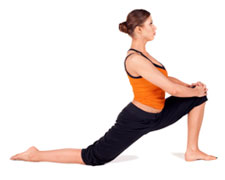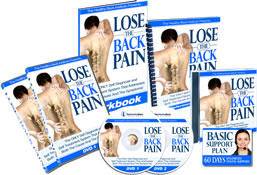Back Pain Exercises and Stretches…Can They Really Give You Pain Relief?
By Steven Hefferon, CMT, PTA, CPRS
When you spend enough time working with people who are in pain, you hear it all: anger, fear, hope – but mostly frustration. Whether you are going through a treatment program for your back pain with a chiropractor or physical therapist, or trying your own exercise program (Yoga, Pilates, pumping iron at the gym, etc.), if you’re not getting relief, let me share with you a widely known “secret.”
Knowledge Is Power
Our mission here at the Healthy Back Institute is to inspire you through education. We know that people who understand their situation and their condition get better care and faster results, regardless of the type of treatment they are going through. The reason is simple: They have more control.
The problem is that most treatment programs only you tell what to do. You never question and never really understand what you’re doing. You just trust that the person telling you what to do is knowledgeable and has your best interests in mind.
Well, here’s a shocker: The person working with you is only doing his job. He likely doesn’t have time to share with you all he knows. More importantly, he may not be willing to take the time to tell you what you need to know to get better and stay healthy.
I’m about to share with you something I have already shared with untold millions. Thank goodness you took the initiative to search for a better way of stretching and exercising. Be prepared to say good-bye to frustration and hello to hope.
Step One: Stop Everything You Are Doing
Why stop what you are doing? Because if you don’t, the underlying factors of your condition could be making things worse. The only way stretching and exercise will be of benefit to you and your condition is if you understand exactly how your body is out of balance. More specifically, you need to know which muscle groups are tight, which muscle groups are weak, and how those imbalances are affecting your body as a whole.
The goal of any stretching and exercise program for someone with back pain is to bring the body back to a balanced state. That includes making sure that your muscles are in balance with each other and that your bones are positioned as they should be, so that your joints can function with precision.
If a muscle group is too strong or too tight and your bones are pulled out of their proper position, eventually our joints will not work correctly and will suffer increased wear and tear until movement becomes painful. Some people call it getting older; I call it premature aging.
What is most challenging about the back is that of the more than 600 muscles, nearly all of them play some role in the health and proper functioning of the back. In short, the more out of balance your muscles are, the more likely you are to develop a condition that will cause you pain.
Common Stretching Mistakes
If you have back pain and you go to see an expert who tells you that you have tight hamstrings (the muscles in back of your upper legs), he will, of course, tell you to stretch your hamstrings. Well, if this expert fails to take into consideration the other imbalances in your body, you will be making your condition worse.
Disclaimer: To help you understand this, I’m going to give you an example. It is only an example and may not be true for you, so you should not consider this as a treatment.
The Most Important Concept I’ll Ever Give You
Keep reading until you see this clearly in your mind and comprehend it. The most important aspect in understanding how your body is out of balance in relation to back pain is the position of your pelvis. Your muscles can pull your pelvis in many different directions. If your pelvis is in an abnormal position, your spine will follow and go into abnormal curvature. This abnormal curvature will, over time, cause your condition to become painful and gradually get worse.
In this example, if your pelvis is pulled forward or tipped forward (the technical term is lordosis) by the strong and tight muscles in the front of your legs and you stretch your hamstrings as instructed, you will lengthen your hamstrings. This will allow your pelvis to tip forward even more – by the couple of millimeters you just gave it by stretching your hamstrings.
You see, your hamstrings are attached below your knee and to your pelvis, so to you or the expert they will feel tight. But the truth is that they are taut – in other words, they are already stretched out because the pelvis is pulling on them. If that same expert were to take the time to identify the strength versus flexibility imbalances related to your pelvis – instead of simply stretching your hamstrings – he could then give you a very specific and targeted stretching and exercise program to bring your pelvis back to a more neutral position. This would also return your back to a more neutral curvature.
The Problem
As I see it, the biggest problem is that 99 percent of the time you want to do – or are told to do – a balanced workout. But if you are already overly strong in some muscle groups and continue to strengthen those same groups, you will only reinforce your imbalances. The same holds true for stretching: If you stretch a muscle group that does not need to be stretched, the imbalance is never going to be corrected.

I know it’s frustrating to be told that your workouts have been making your back pain condition worse, or may even be partly responsible for the condition in the first place. And while it’s true that Yoga and Pilates are all about balance, these programs are for those who do not have a problem. But for someone with back pain due to muscle imbalances, a general stretching and exercise program is the last thing you want to be doing.
The Solution
Regardless of age, sex, fitness, or fatness, we all have imbalances and we all need to understand that stretching and exercise can play a very important role in how we live our lives and how healthy we stay as we grow older. Once you embrace the concept of imbalances, you need to identify where they occur in your body. Then you need to do a very specific and very targeted stretching and exercise program. And guess what? It will be a very unbalanced workout. Yes, that’s what I want you to do – an unbalanced workout to get back into to balance. Then you can do your Yoga or Pilates.
You now know more than the average person about stretching and exercise, and I haven’t even shown or told you about a single one I would recommend. When it comes to back pain, the point is that knowledge is critical. And, in some cases, doing nothing is better than doing what you’re told – if it’s the wrong thing.
Remember, no one cares more about your back than you. So, it is critical that you are able to talk to your health care providers in a way that tells them they cannot just give you the same cookie-cutter program they give everyone else. Once they realize they can’t bullshit you, they’ll have to step up their game.
The Lose The Back Pain System is the only self assessment – self treatment system that shows you the exact stretches and exercises, that you can do from the comfort of your own home, which will give you the lasting relief you are after.
Click Here to Learn More About the Lose The Back Pain System
Good luck…
The techniques and principles taught by the Healthy Back Institute are based on the Muscle Balance Technique™, the most widely accepted and fundamentally sound approach to using stretching and exercise as a treatment for back pain.
50 Years of Back Pain Gone in Just Days!
Jerry Talisman had suffered from chronic back pain on and off for over 50 years. Like most people, he had tried it all… chiropractors, physical therapy, he even overdosed on tylenol but nothing gave him lasting relief until he discovered muscle balance therapy.
Unlike most treatments which only deliver temporary relief, if any at all, muscle balance therapy delivers lasting relief to 8 out of 10 people who use it because it addresses the underlying cause of the pain, not just the symptoms.
If you suffer from any type of back pain, neck pain or sciatica, I urge you to learn more about this breakthrough new treatment. Click here to learn more…
Written By: Updated: May 13,2011



